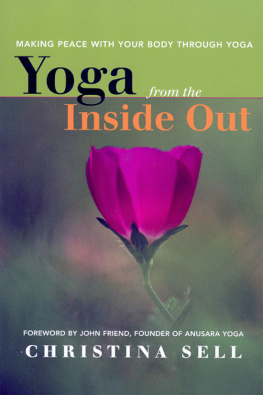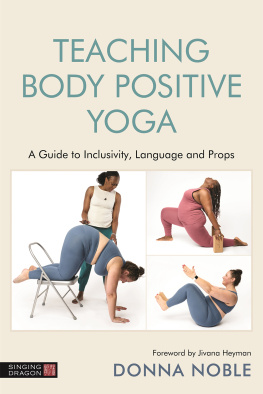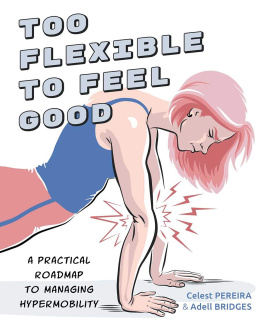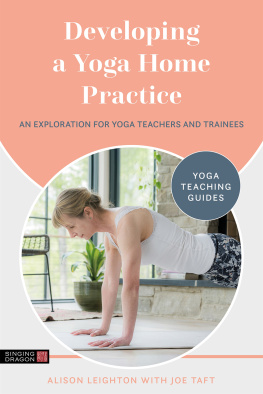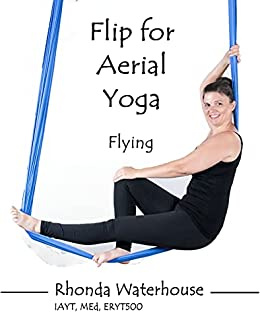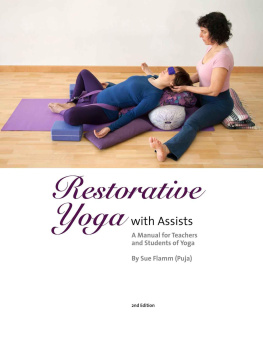Contents

Hypermobility
on the YOGA Mat
A Guide to Hypermobility-Aware
Yoga Teaching and Practice
JESS GLENNY
Foreword by Jules Mitchell

Contents
Foreword
Jess Glenny has shown up strong for the yoga community by writing this much-needed text for a population who will benefit from it for years to come. Modern postural yoga has become synonymous with flexibility, an asset that many appear to possess while silently living in discomfort, confusion and a diminished sense of embodiment. Likewise, flexibility has become synonymous with hypermobility, a complex condition that is defined by a collection of symptoms far beyond just appearing to be good at yoga. Jess clearly articulates why these associations are incomplete at best and inaccurate at worst.
During my last decade of writing about tissue mechanics for the yoga population, I clearly recognised the lack of available research on hypermobility. There was just enough information to help me articulate that the condition was not a function of stretching and that stretching need not be vilified indiscriminately. Jess takes this basic premise and expands upon it tenfold, providing the reader with a comprehensive guide on how different styles of yoga can safely and effectively benefit hypermobile practitioners.
Only in recent years is hypermobility becoming more recognised by the medical community, resulting in a wide range of possible diagnoses under the hypermobile umbrella, as well as an awareness of how hypermobility expresses differently across individuals. Jess patiently outlines all the potential challenges someone with hypermobility might face and how they might choose to approach their yoga practice in response. Her book is full of personal anecdotes and includes insightful quotes from not only researchers and yoga educators, but also the students themselves. She truly grasps how important it is to hear directly from those whom the book is intended to benefit.
Because yoga tends to select for individuals on the hypermobility spectrum, Jess Glennys work is especially important. She brings awareness to a crucial topic while maintaining her position as a yoga teacher rather than a medical professional or scientific researcher. For this reason alone, her book will serve many who might otherwise not have to access to this information. Hypermobility on the Yoga Mat will help yoga teachers and students navigate the practice we love while empowering us to make informed decisions about when to seek further care.
Jules Mitchell MS, LMT, RYT
Yoga Educator, Research and Adjunct Faculty, Arizona State University
Author: Yoga Biomechanics: Stretching Redefined
www.julesmitchell.com
Notes on the Text
Terminology
At present, there is no word in English to denote those who are not genetically hypermobile. For this purpose, I have coined the term CT-typical. CT stands for connective tissue.
Disclaimer
Many of the first-person quotations that head up chapters and sections are from actual yoga teachers and hypermobile yoga students who have kindly agreed to have their words included in this book. Others are fictionalised amalgamations of the experiences of different teachers and practitioners, and any resemblance here to real teachers and real students is only that.
Introduction
When I set out my stall, in 2003, I had no intention of specialising in hypermobility teaching. Hypermobile students came anyway. At that point, there was little awareness of the joint hypermobility syndromes in the yoga world, and most of us with genetic hypermobility were very poorly served by the existing attitudes and approaches to working with what, at the time, was rarely identified as a physiological condition. Historically and continuing on today yoga teaching has been geared towards CT-typical practitioners, for whom increasing flexibility may be a genuine need in creating biomechanical balance. The cues that serve this population are obviously very different from those that are helpful and appropriate for a hypermobile person, whose main needs are for structure and stability. I had no formal training (none existed) or particular experience in teaching hypermobile people, but I did have some knowledge about hypermobility more than most other yoga teachers and a familiarity with the territory in my own body, gained through practising yoga with hypermobile Ehlers-Danlos for over 20 years. And so it began.
I wasnt then, and Im not now, a medical professional, a scientific researcher or any kind of expert on hypermobility. The suggestions in this book grow out of my own practical experience of making yoga friendly, accessible and helpful to hypermobile people ranging from elite professional dancers to those who are very incapacitated. Together we have generated a body of knowledge. Good movement strategies are key here, but theyre not everything. An authentic practice resonates, repatterns, informs and pleasures. It leads us into the centre of our experience and reveals increasingly subtle sensations, emotions, and mental and nervous-system activities, so that over a period of time, the practising body becomes an ever-more intelligent system, a place where we can feel at peace and be at home. This is a process that encompasses but is much bigger than biomechanical recalibration.
Words have the tendency to nail thoughts down. Nevertheless, its not the intention of this book to circumscribe what or how a hypermobility-aware practice should be. Ultimately, this is something that can only be discerned by the individual. As Body-Mind Centering founder, Bonnie Bainbridge Cohen, says:
The real key is to perceive what youre doing. I really cant teach you, but I can help you focus on your awareness so that you can discover what you are doing. Then you have choice.
Practice is an intimate process. The role of the teacher is to offer relationship based on witness and informed suggestion, appropriate to the knowledge and experience of the student. That said, there is a great hunger for information and guidance among hypermobile yoga practitioners. I receive many requests, from all over the world, for advice about how to practise in ways that tend towards kinetic integrity rather than pain and dysfunction. If you are a hypermobile student of yoga, I hope that the signposts in this book will point you down generative pathways.
Yoga teacher training and hypermobility
While consciousness of genetic joint hypermobility has increased greatly in the yoga world during my time on the mat, the need for education among yoga teachers about what hypermobility is and how to work with it is still great. Once you have a hypermobility-aware eye, a quick glance around pretty much any general yoga class will reveal a considerable over-representation of hypermobile people relative to the population at large. However, yoga teacher training may include little or no content on working with hypermobile students. To get some idea of the current situation in this respect, I conducted a straw poll among teachers in two large online yoga teacher groups.
The earliest yoga teacher training reported was in 1972 (we hadnt heard of hypermobility then). The most recent was ongoing (in 2019). One trail-blazing, and CT-typical, British Wheel of Yoga teacher trainer, Andrea Newman, was including fairly extensive information about working with hypermobility in the early nineties. However, the majority of teachers graduating in 2016 or earlier had not received any hypermobility education. It was heartening to see that graduates in 2017 and onwards were much more likely to have received some input on working with hypermobility. However, in terms of what was taught and how knowledgeable and experienced the trainers were in the area of hypermobility themselves, things were still pretty patchy. Very few of even the recent graduates had been given any information about co-existing conditions and the multi-systemic nature of hypermobility. Training generally focused quite narrowly on biomechanics mainly on limiting end range of motion, fixing hyperextensions and building strength rather than working for flexibility a lens that gave some graduates a rather skewed idea of what hypermobility actually is and what kinds of experiences hypermobile students might be having in their classes. Some teachers had sought to address this knowledge gap through continuing professional development (CPD) and discovered that although the situation is improving slightly there is a dearth of good-quality post-graduation training in hypermobility available for yoga teachers.


